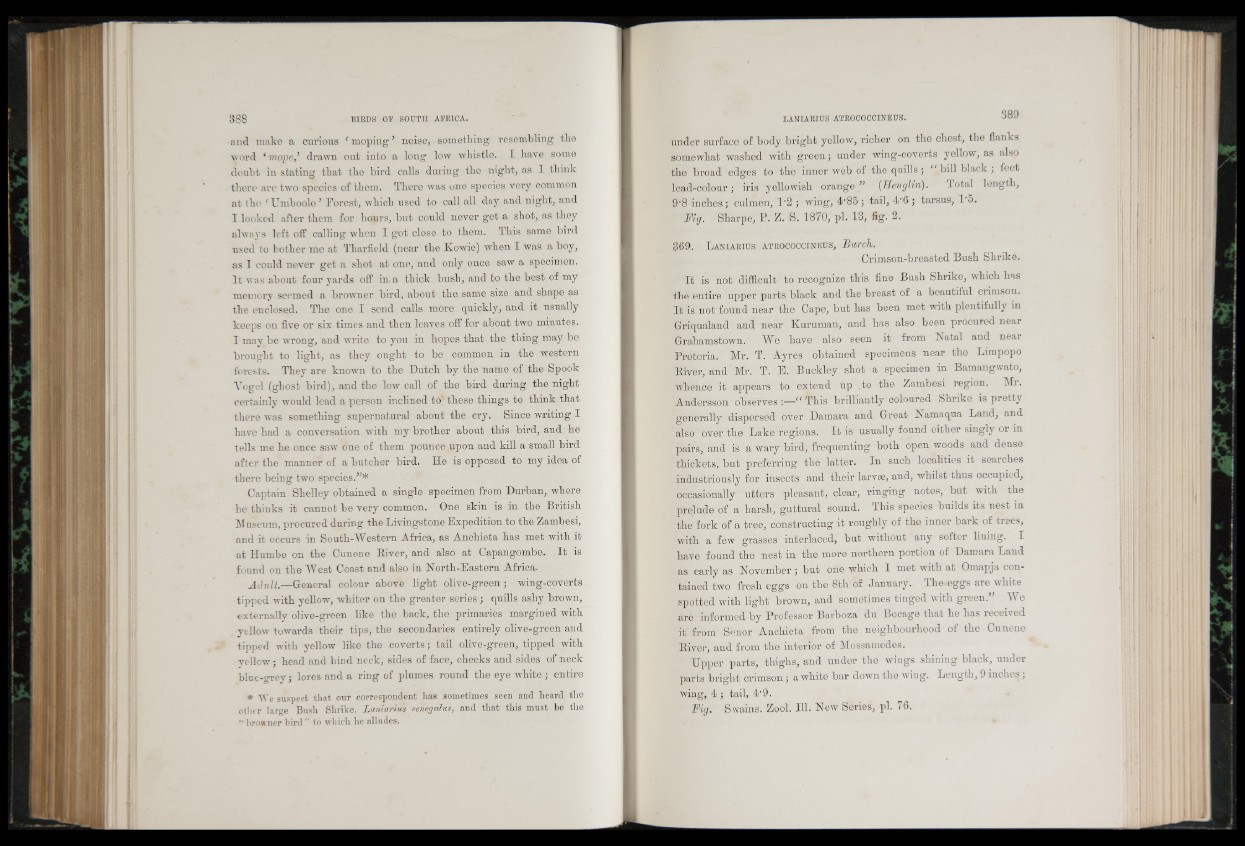
and make a curious f moping ’ noise, something resembling the
■word ‘ mope/ drawn out into a long low whistle. I have some
doubt in stating that the bird calls during the night, as I think
there are two species of them. There was one species very common
at the ‘ Umboolo ’ Forest, which used to call all day and night, and
I looked after them for hours, but could never get a shot, as they
always left off calling when I got close to them. This same bird
used to bother me at Tharfield (near the Kowie) when I was a boy,
as I could never get a shot at one, and only once saw a specimen.
It was about four yards off in a thick bush, and to the best of my
memory seemed a browner bird, about the same size and shape as
the enclosed. The one I send calls more quickly, and it usually
keeps on five or six times and then leaves off for about two minutes.
I may be wrong, and write to you in hopes that the thing may be
brought to light, as they ought to be common in the western
forests. They are known to the Dutch by the name of the Spook
Yogel (ghost bird), and the low call of the bird during the night
certainly would lead a person inclined to these things to think that
there was something supernatural about the cry. Since writing I
have had a conversation with my brother about this bird, and he
tells me he once saw one of them pounce upon and kill a small bird
after the manner of a butcher bird. He is opposed to my idea of
there being two species.”*
Captain Shelley obtained a single specimen from Durban, where
he thinks it cannot be very common. One skin is in the British
INI useum, procured during the Livingstone Expedition to the Zambesi,
and it occurs in South-Western Africa, as Anchieta has met with it
at Humbe on the Cunene River, and also at Capangombe. It is
found on the West Coast and also in North-Eastern Africa.
Adult.—General colour above light olive-green; wing-coverts
tipped with yellow, whiter on the greater series ; quills ashy brown,
externally olive-green like the back, the primaries margined with
yellow towards their tips, the secondaries entirely olive-green and
tipped with yellow like the coverts; tail olive-green, tipped with
yellow; head and hind neck, sides of face, cheeks and sides of neck
blue-grey; lores and a ring of plumes round the eye white ; entire
* We suspect th a t our correspondent has sometimes seen and heard the
other large Bush Shrike, Laniarius senegalus, and th a t this must be the
“ browner bird ” to which he alludes.
under surface of body bright yellow, richer on the chest, the flanks
somewhat washed with green; under wing-coverts yellow, as also
the broad edges to the inner web of the quills; “ bill black; feet
lead-colour; iris yellowish orange” (Heuglin). Total length,
9'8 inches; culmen, 1'2 ; wing, 4'85; tail, 4‘6 ; tarsus, 1 5.
Fig. Sharpe, P. Z. S. 1870, pi. 13, fig. 2.
869. L ania r iu s atrococcineus, Burch.
Crimson-breasted Bush Shrike.
It is not difficult to recognize this fine Bush Shrike, which has
the entire upper parts black and the breast of a beautiful crimson.
It is not found near the Cape, but has been met with plentifully in
Griqualand and near Kuruman, and has also been procured near
Grahamstown. We have also seen it from Natal and near
Pretoria. Mr. T. Ayres obtained specimens near the Limpopo
River, and Mr. T. E. Buckley shot a specimen in Bamangwato,
whence it appears to extend up ,to the Zambesi region. Mr.
Andersson observes :—“ This brilliantly coloured Shrike is pretty
generally dispersed over Damara and Great Namaqua Land, and
also over the Lake regions. I t is usually found either singly or in
pairs, and is a wary bird, frequenting both open woods and dense
thickets, but preferring the latter. In such localities it searches
industriously for insects and their larvae, and, whilst thus occupied,
occasionally utters pleasant, clear, ringing notes, but with the
prelude of a harsh, guttural sound. This species builds its nest in
the fork of a tree, constructing it roughly of the inner bark of trees,
with a few grasses interlaced, but without any softer lining. I
have found the nest in the more northern portion of Damara Laud
as early as November; but one which I met with at Omapj a contained
two fresh eggs on the 8th of January. The eggs are white
spotted with light brown, and sometimes tinged with green.” We
are informed by Professor Barboza du Bocage that he has received
it from Senor Anchieta from the neighbourhood of the Cunene
River, and from the interior of Mossamedes.
Upper parts, thighs, and under the wings shining black, under
parts bright crimson; a white bar down the wing. Length, 9 inches;
wing, 4 ; tail, 4-9.
Fig. Swains. Zool. 111. New Series, pi. 76.